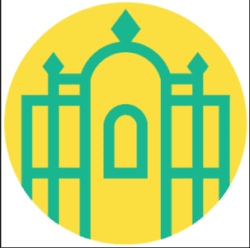Lighthouse, Alexandria, 300 BCE
Pharos, the ancient lighthouse of the port city of Alexandria, was one of the seven ancient wonders of the world. Built on an island in the harbor of Alexandria, the Greeks created a causeway the lead to the island and separated the port into two. Ptolemy commenced this magnificent building around 297 BCE, to protect ships from the precarious nature of the harbor. Greco-Roman architecture was used in designing the lighthouse. The bottom of Pharos rose to a height of sixty meters, while the octagon and the top circular portion of the lighthouse were thirty and fifteen meters respectively. These dimensions make Pharos a monument of grandiose proportions–it is said that the light from the top could be seen for 34 1/2 to an amazing 300 miles away. The fire would have been placed at the bottom of Pharos. Mirrors, made of very polished bronze, lined the entire inside projected the fire onto a mirror at the top. During the day, the sun’s rays were used to project the light; this was convenient since Pharos was mainly used during the day, as many ships did not sail at night.
Method of Construction
Constructed by: Dawn Turek and Christine Wraga
We have built the ancient lighthouse of Pharos out of a wooden frame that we then covered with “ancient” plaster. To achieve a “stone” finish, we then covered the plaster with an air drying clay. We had a few mishaps and cracking, which can be attributed to the ancient earthquakes that eventually toppled Pharos. In addition to the clay, we applied mixtures of paint to create the stone finish, architectural embellishments, and windows that appeared on each level of the lighthouse. We used the colors red and blue because these are common colors that were used in painting ancient Greek architecture. The white of the clay was used to represent the white marble that was thought to have sheathed the surface of the lighthouse. To shrink Pharos to a reasonable size, we set 12″ as the base and then made each additional level, the octagon and the circle, half as large as the previous level, proportional to the measurements of the original lighthouse. We agree with our peers, these projects do take longer than anticipated. We encountered many problems, from structural (the leaning lighthouse of Pharos) to plaster and clay (cracks are earthquake damage) to paint (certain areas of the tower required 6 to 8 coats!). Through painting we attempted to make the tower’s architectural accents appear three-dimensional. We included arches, metopes and tridents, columns, and even sculptured corners of fish that symbolize the sea. The top portion holds a candle that provides the fire to be reflected by a round mirror. Although it is known today that the fire was in the base, many medieval visuals of Pharos depict the tower with flames coming out of the top, we did not want to burn down our wooden/plastered/clayed surface. Thus, our working model is a representation of one of the theories of how the lighthouse worked. Our lighthouse reflects the light off towards the left for some distance. All in all, we are very proud of our Pharos, which has taken us time, coordination, and creativity to construct. May it join the other ancient invention models in representing the ingenuity of our ancestors.
Resources
Clayton, Peter A. and Price, Martin J. The Seven Wonders of the AncientWorld. Routledge: New York, NY, 1989
James, Peter and Thorpe, Nick. Ancient Inventions. Ballantine Books:New York, NY, 1994




